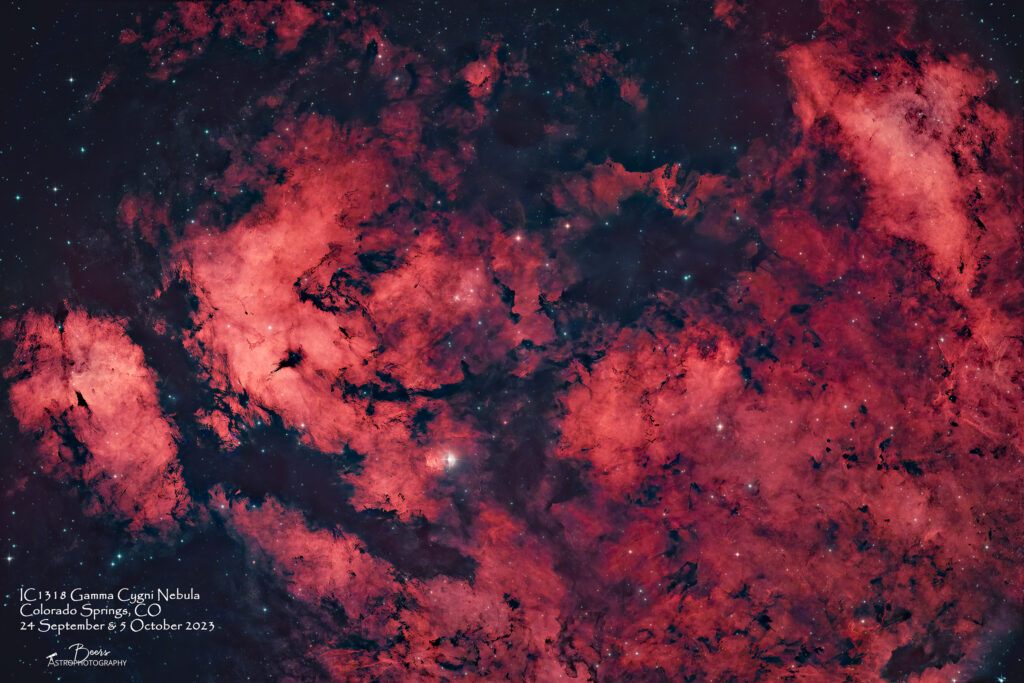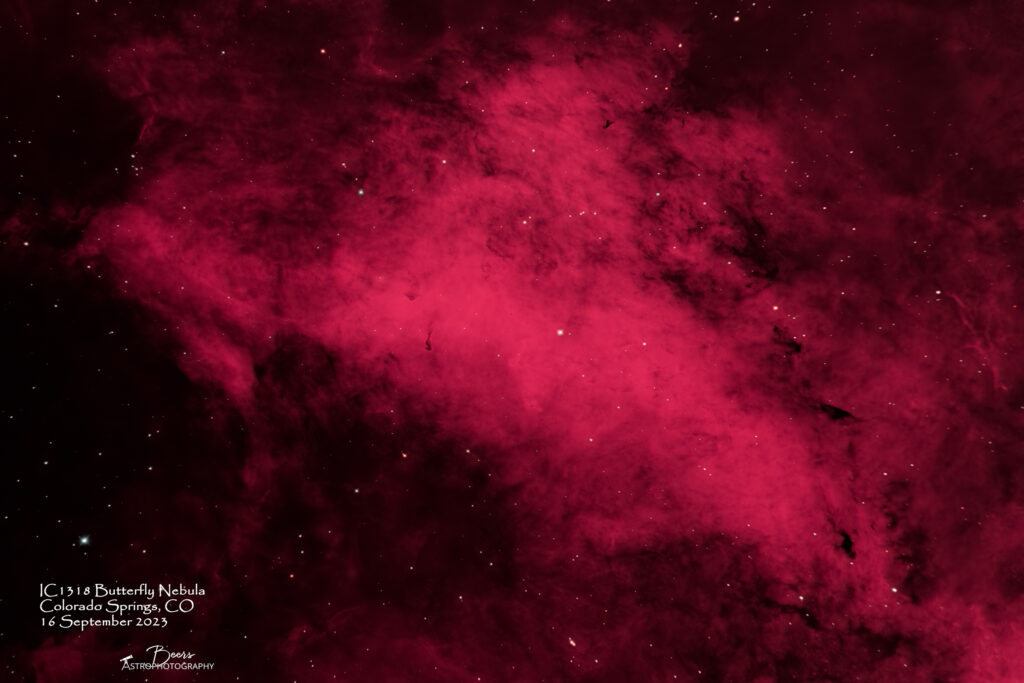
Fun facts
The Gamma Cygni Nebula, also known as the Sadr Region or IC 1318, is a diffuse emission nebula that can be seen around Sadr (Gamma Cygni). Sadr is one of the bright stars of the Northern Cross and it marks the heart of the celestial Swan. It is a white supergiant star with an apparent magnitude of 2.23. With 12 solar masses and 150 times the Sun’s radius, the star is about 33,000 times more luminous than the Sun. Despite the name, the star and the nebula are unrelated. Even though it looks embedded in the nebulosity (not in my image – it is out of the frame), Sadr is approximately 1,800 light years distant, while the nebula is much further away, at 4,900 light years.
The Gamma Cygni Nebula is considered an emission nebula because it is ionized by the radiation of the nearby stars and it emits visible light as a result. The visible portion of the HII region stretches over an area more than 100 light years across. The nebula is illuminated by an O9-class star which is visually obscured by interstellar material.
The Gamma Cygni Nebula has three distinct parts, designated as IC 1318 A, B and C. The dark cloud about 20 light years thick that divides IC 1318 B and C is a dark nebula known as LDN 889. It is physically related to the emission nebula and the surrounding molecular cloud complex. The dark dust lane is responsible for the nebula’s distinctive shape, resembling that of a butterfly, which is why IC 1318 is sometimes also known as the Butterfly Nebula. The components IC 1318 B and C are not separate parts of the nebula, but a single cloud visually separated by LDN 889.
IC 1318 is termed here (a.k.a. Butterfly Nebula) so as not to be confused with the Butterfly Nebula (NGC 6302), a bipolar planetary nebula located in the constellation Scorpius, the bright planetary Butterfly Nebula (NGC 2346) in Monoceros constellation, or the planetary nebula known as Minkowski’s Butterfly (M2-9) or the Twin Jet Nebula located in Ophiuchus.
Other Catalog Designations: IC1318, LBN245, Ced176c
Subtype: Emission Nebula (HII region)
Distance from Earth: 4900 light years (according to Constellation Guide), 815.5 light years (according to Stellarium)
Apparent Size: 45′ x 20′
Constellation: Cygnus
{ From: https://www.constellation-guide.com/gamma-cygni-nebula-sadr-region/ and Stellarium }
Capture & Processing Notes
Capture Notes: Beginning on Sunday, 24 September 2023 we had a week of clear skies at home (with the moon building to the full Harvest Supermoon on Friday, 29Sep2023). I had finally convinced Orion that I REALLY did need the extension tube for Big Bertha and they relented to sell it to me. I ordered on it Friday, 22 September and it was to be shipped on Monday. So, I decided to use the Southern Cross while I waited for the missing piece to make ASI2400-BB whole. On 24Sep, I captured the IC1318 Gamma Cygni after the M16 Eagle Nebula set, until it set (ran into the corner of the house) at approximately 0300MDT. On 5Oct, I started the night with IC1318 and imaged it until approximately 0200MDT when it was getting near setting and I wanted to switch to make time for the 2-tile mosaic of Spaghetti Nebula.
Equipment: All equipment controlled by HP Probook (DSO CTRL 1) Windows 10 laptop running Sequence Generator Pro v3.2.0.660.
Polar alignment: QHYCCD camera (controlled by Polemaster for polar alignment)
Imaging: (Southern Cross) Askar FRA600 on Rainbow Astro RC-135E, ZWO ASI2400MC#1 camera, Optolong LeXtreme light pollution filter
Mount: Rainbow Astro RC-135E (controlled by iHubo ASCOM driver)
Autoguiding: Orion 60mm Multi-Use Guide Scope with Orion StarShoot AutoGuider Pro Mono Astrophotography Camera (controlled by PHD2)
Processing notes
Sequence plans:
- 24Sep2023: Gain: 158, Temp: -0°C, offset=NotSet, Bin: 1×1, 43x5min. Captured 24Sep2023, 2013 – 2248MDT. Total exposure time: 3:35hrs.
- 5Oct2023: Gain: 158, Temp: -0°C, offset=30, Bin: 1×1, 61x5min. Captured 5Oct2023, 2124MDT – 6Oct2023, 0145MDT. Total exposure time: 5:05hrs.
Total exposure time: 8:40hrs
Shooting location: HCH, Colorado Springs, CO
Processing summary: As usual, I captured the data with SGP, stacked in APP, removed stars with Starnet++, and processed with LR/PS.
I had stacked the two sessions individually, immediately after capturing them, but had not had a chance to process before we left for Los Alamos on 12Oct2023 for the solar eclipse. So, after the eclipse processing, Christmas card collage building, and SH2-129 Flying Bat processing, on 22 Oct 2023 I finally got a chance to process the multi-session image. I first tried to register and normalize the finished FITS files from the individual sessions, but that results in two separate files that are aligned, but not combined. So, I resorted to my usual multi-session stacking process, then continued with my “standard” (slightly different with each image) Starnet++ star removal and LR/PS processing.
Other images of IC1318 Gamma Cygni (Butterfly) Nebula

Capture Notes:
This image was captured on Saturday night (16Sep2023) during a dual-rig imaging frenzy on the one clear night I had after a long wet, rainy, cloudy, stormy spell and before I departed for a week of business travel. I got a second Optilong LeXtreme filter, the ASI2400MC DC power cable from Tolga, and Paul finished up the “Chile” battery — so with that I now have two of everything I need to run two rigs simultaneously. That is exactly what I did — to make the most of the one night I had! I started the night getting Big Bertha going first on her target(s) as she was planned to image two targets. This was the first of the two targets captured from dark until about 0230MDT when it was getting close to setting and IC59&IC63 Ghosts of Cassiopeia was past its meridian flip. The capture went well except for a short break at approximately 20 minutes before the meridian flip, where the autoguider lost its guide star and terminated the sequence. I got it going again about 20 minutes after the meridian flip for the rest of the planned collection time.
Equipment
Polar alignment: QHYCCD camera (controlled by Polemaster)
Imaging stream: (Big Bertha) Orion 8″ f/8 Ritchey-Chretien Astrograph Telescope, ZWO ASI2400MC#2 imaging camera, Optolong LeXtreme light pollution filter
Mount: SkyWatcher EQ6‑R PRO Synscan mount (controlled by ASCOM driver)
Autoguider: Orion 60mm Multi-Use Guide Scope, Orion StarShoot AutoGuider Pro Mono Astrophotography Camera (controlled by PHD2)
All equipment controlled by Windows 11 HP Probook (DSO-CTRL-2) running Sequence Generator Pro v4.2.0.16.
Capture & processing notes
Sequence plan: Gain: 158, Temp: -0°C, offset=30; 65x5min. Total exposure time: 5:25hrs.
Captured: Captured 16 September 2023 (16Sep2023, 2024MDT – 17Sep2023, 0232MDT).
Shooting location: HCH, Colorado Springs, Colorado
Processing: Captured with SGP, stacked in APP, star removal with Starnet++, processing with LR/PS.
I decided to give Nico Carver’s dual narrowband colorizing technique (3 Ways to edit Dual Narrowband Astrophotography! at https://www.youtube.com/watch?v=hLGjXJ3FxO0&t=2181s) a try with this image. I’m not certain the “juice is worth the squeeze” at least for this image (my one and only data point so far) as compared to the workflow I have been using for enhancing tone and color (taking the almost finished nebula-only image into LR and using the Alyn Wallace presets (https://alynwallacephotography.com/astro-workflow-lightroom-presets) that I finally broke down and bought earlier this year. There was a lot of signal in the green and blue channel, but it’s exactly in the same spot as the red signal – so all I got was tone/hue/overall color changes (some that were very hideous looking in the midst of the process). So, I’m guessing that when all the signal is in the same spot separating out and putting back together doesn’t have much effect. …and I’m not sure I like the magenta I ended up with, but after fiddling with it for a couple of hours – I’m calling this a “front patio placeholder” and adding to my “reshoot in dark skies” list…
